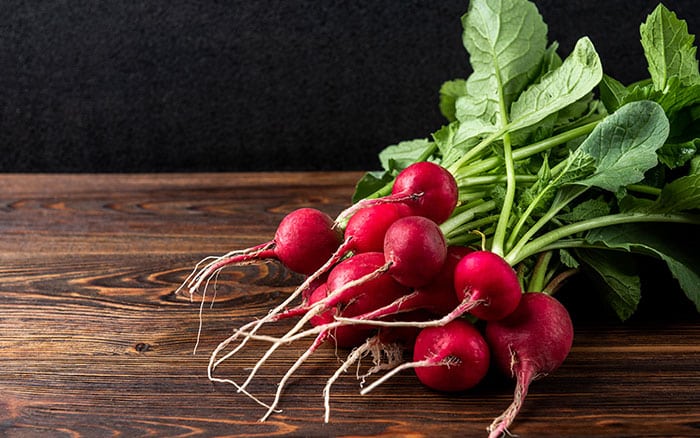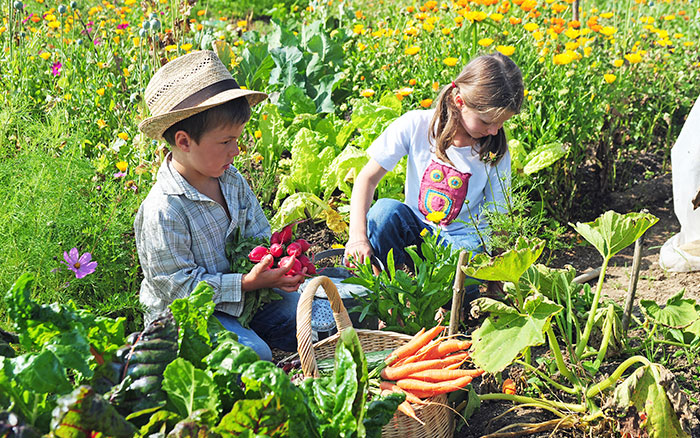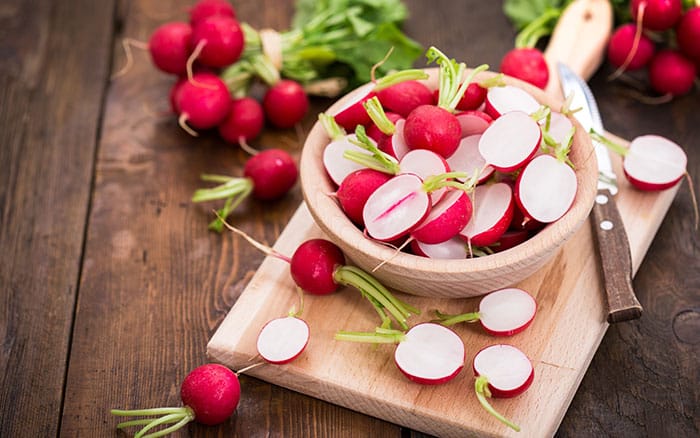How to sow and grow radishes UK
If you’re looking for a little extra crunch in your salad this summer, radishes are an absolute must-grow in your school and community gardens.

Super quick and easy to grow, radishes are the perfect brassica for school and community gardens. Because they’re compact plants, they can grow in the smallest of spaces. This means they’re great gap fillers for allotments. Plus, they’re super speeder growers. They take as little as four weeks. This makes them great starter brassicas for kids, as the magic doesn’t require much patience!
Radishes are considered to originate from the Eastern Mediterranean region, China, and Middle Asia. And they were highly prized by the Ancient Greeks. So much so, that they actually make small replicas of them from gold. Now that’s real love!
Are radishes good for you?
When you look into the health benefits of radishes, it’s no surprise that the Ancient Greeks held them in such high esteem. You need around 10 radishes to tick off one of your five-a-day. And just half a cup of radishes constitutes around 15% of your daily intake of vitamin C. That’s impressive stuff!
- Radishes are good for the heart! As a source of sulforaphane and plant compounds, like anthocyanins, they help to reduce inflammatory damage caused by oxidative stress. By reducing this stress, radishes reduce the chances of developing heart disease.
- They’re full of vitamin C! This vitamin, alongside other antioxidants, helps to protect the body's cells from the damaging effects of ageing and less healthy lifestyles.
- They could help to support liver function and digestion. Radishes may stimulate digestive juices, particularly bile flow. Bile is produced by the liver and helps to digest and manage fats, as well as remove toxins and waste from the liver.
How do you grow radishes?
1. Make your bed!

Pick a dry day to prepare your bed, before you start sowing. Use a fork to break down any large lumps, and remove any weeds. Rake the soil to a fine tilth. Make sure to remove any large rocks and lumps of earth. These could hinder the progress of emerging seedlings!
2. Sow what?

Next, create a drill using a trowel and a line and reel. You can also just attach a length of string to a cane at either end of the row. Sow in spring, early summer, and late summer for best results.
You can also sow in mid-summer, but make sure you pick a shaded spot that stays cool. Space out your seeds individually, according to the packet instructions.
3. Care a little, care a lot.

Once you’ve sown your seeds, cover them with a light lay of soil, and water them with a rose attachment. This is the attachment that best mimics rainfall. Make sure to keep watering on a weekly basis when conditions are dry.
Your seeds should germinate within 10 days. Once they’re big enough to handle, you’ll need to thin them out. Cut down the leaves until there’s about 2.5cm between plants. If your plants are too small and fiddly to thin, remove the smaller, weaker ones. It might seem a shame, but you’ll be left with a stronger, tastier crop.
Plus, remove any weeds. These will compete with radishes for water and nutrients. To remove the weeds, simply take them out individually or hoe between each row.
4. The best bit...

Radishes are at their most delicious when young. When you leave them in the ground too long, they develop a woody texture and bitter flavour. They should be ready to harvest after about 4 weeks, but if you’d like to double-check, scrape away the top layer of soil. If the radish is roughly 2cm in diameter, you can gently pull it from the ground. If you’ve gone for early sowings, bear in mind that they take around six to eight weeks to be ready.
How and where do you store radishes?
As ever, radishes are tastiest eaten as soon as they’re harvested. But we know this isn’t always possible. The good news is, you can store your radishes in the fridge. They should keep around 1-2 weeks, sealed in a plastic bag. Just make sure you keep the roots intact and don’t wash them until you’re ready to eat them.
You can also store radishes in the freezer. To do so, simply wash them thoroughly, and slice them thinly. Place them in a large pot of boiling water and blanch the slices for 2-3 minutes. Then, remove them from the hot water and plunge them into icy water for 2-3 minutes. This process makes sure the radishes don't lose their flavour, colour, and texture. Next, place them in a freezer-safe and pop them away for another day!

And there you have it! The recipe for adding radishes to your school or community garden. And, even if you’re not a fan of the peppery kick they add to salads, you’re sure to get a kick from how quick and easy these brassicas are to grow!

